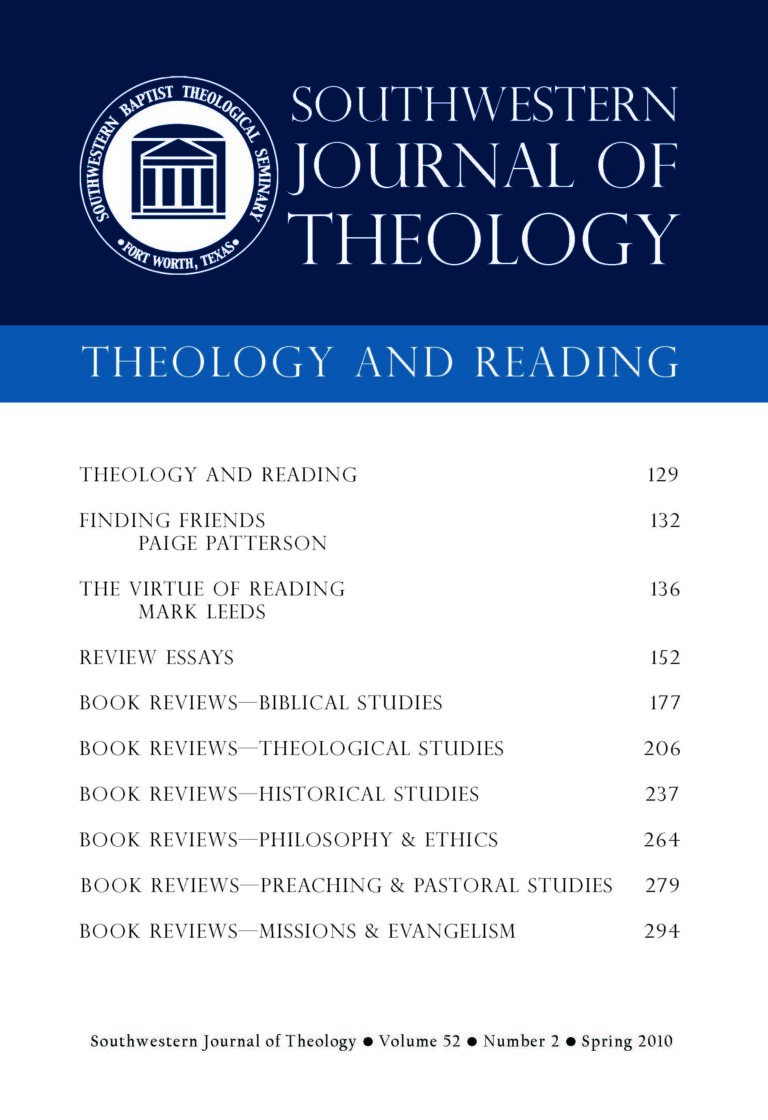
Theology and Reading
Southwestern Journal of Theology
Volume 52, No. 2 – Spring 2010
Managing Editor: Malcolm B. Yarnell III
By Paul Trebilco. Grand Rapids: Eerdmans, 2007. 826 pages. Paperback, $85.00.
Paul Trebilco’s work represents a substantial endeavor in describing the ancient urban life of Ephesus in light of its early Christian believers. The purpose is twofold: first, to look at the life and activity of the early Christians, and, second, to argue that there was not a single body of believers in Ephesus, but a number of believing groups or communities. Trebilco’s erudition of ancient Ephesus is undeniable from the introduction, which explains how recent interests in Ephesus have sparked in the form of historical undertakings in cultural studies, sociological dimensions, cultic presence, and new archaeological findings. The scope of Trebilco’s research is not in any way a wholesale assimilation into any one of these historical approaches. The difference in Trebilco’s voluminous work is his careful examination of the biblical texts connected to Ephesus. Trebilco takes these canonical sources seriously enough to allow them to tell the history of ancient Ephesus.
The book is divided into four parts, but chapter one stands alone apart from the divisions of the book with an offering of the city’s brief history and significance as a religious center for the cult of Artemis and later, the imperial cult. This first chapter is only a brief treatment of the vibrant spectrum of religious life in the city. The bulk of Trebilco’s book falls into the four parts, which assess the early Christians primarily from the canonical sources and an early letter from Ignatius.
The first part deals directly with the biblical sources, beginning with the Pauline correspondences, and comparing Paul’s descriptions of his stay in Ephesus with Luke’s account in Acts. Noticing the slight nuanced discrepancies, Trebilco here identifies Luke’s tendencies to underscore Paul’s success in Ephesus, glossing over much of the difficulties Paul faced and reiterating the positive effects of the gospel message throughout all of Asia.
Part two looks at what the Pastorals, Revelation, and Johannine letters say about the Christians in Ephesus. Because of the ongoing discussions on the authorship of these letters, Trebilco noticeably sidesteps the issues of authorship, by presenting the varying positions and evidences, while also attributing the specific positions with their respective scholars (e.g. Papias’ views as presented by Richard Bauckham). However, the primary objective is dealing with the content of these others letters with their situations and teaching to make connections with the Christians in Ephesus.
Part three is a rather novel approach that is born out of the narrative critical method. Trebilco looks at the readers of the Pastorals, Revelation, and Johannine letters. The readership includes issues with material possessions, authority, leadership, and women. Trebilco demonstrates how these issues find common grounds with those in Ephesus. Although Trebilco begins to speak of different groups in part two, part three is where he begins to argue for a plurality of readership, which suggests a plurality of communities.
Part four compiles the various aspects of Ephesian life and culture from Ignatius’ letter from Antioch. Some points, which Trebilco observes, include the notable elevated stature of the Ephesian addressees, the Ephesian community’s strong ties with Paul, and the community’s spiritual maturity.
The extensive nature of Trebilco’s work encompasses numerous contributions in the field of study, incorporating not only the research on Ephesus, but also with research in other New Testament writings. With the large number of secondary sources used in completing this work, it is no surprise that Trebilco uses the sources sparsely in what may appear to be uncritically receiving the findings and conclusion. But in no way is Trebilco blindly accepting entire works; his selectivity is his primary mode of critique and the controversial theories are generally left aside.
Moving beyond the categorical boundaries of expositions or commentaries, Trebilco’s work is a multifaceted description of the life and history of the early Christians in Ephesus—a remarkable achievement worthy of a serious look.





